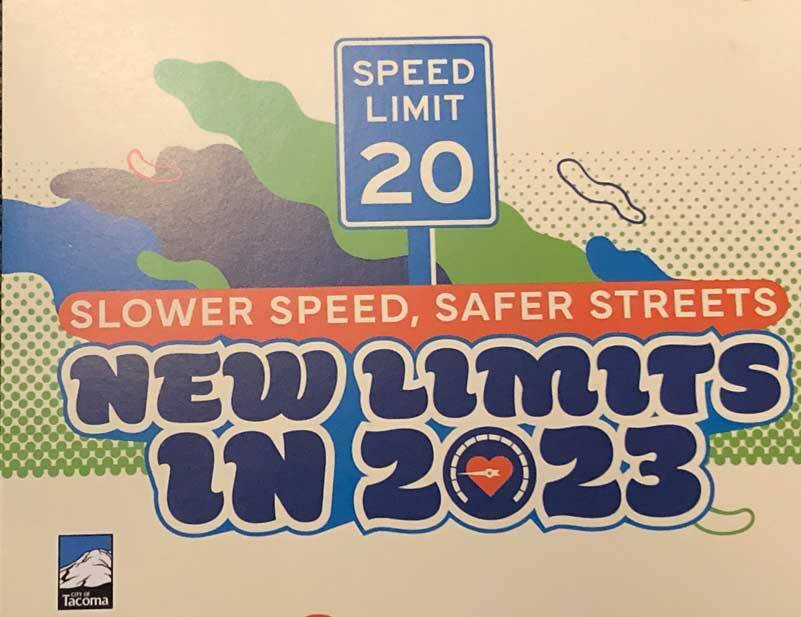By Morf Morford, Tacoma Daily Index
In response to an increase of traffic and especially pedestrian accidents, the Tacoma City Council passed Ordinance No. 28825, which lowers the default speed limit on residential streets from 25 miles per hour to 20 miles per hour.
This ordinance also lowers the speed limit from 30 miles per hour to 25 miles per hour on arterial streets in four Neighborhood Business Districts, including 6th Avenue, Lincoln, McKinley Hill, and Old Town.
The speed limit is already 25 miles per hour in the South Tacoma and Proctor Neighborhood Business Districts.
The new speed limits went into effect on January 1, 2023. New speed limit signage is being installed, plus additional signage will be added in key locations that include gateways to the city and those four Neighborhood Business Districts.
The assumption is that lowering speeds improves safety by reducing the frequency and severity of crashes, improves visibility, provides additional time for drivers to stop, and reduces the potential for fatal or serious injuries by lowering impact forces.
Speed is, of course, a primary element of traffic fatalities and injuries – but it is only one.
And we are not the only community with increasing traffic related incidents.
Every community across the country seems to be facing an increase in road rage, street racing incidents and, yes, driving far faster than conditions would dictate.
And we seem to have more and more drivers that don’t seem to care about pedestrians, other drivers or even their own safety. Or the posted speed limits.
The Los Angeles Times takes it a step further by suggesting that speeding is due to “arousal breakout,” a fervent reaction experienced by those who carry, or even nurture, resentment over lock down restrictions.
They quote one expert as saying that reckless driving is “a sign of the overall lack of consideration we’re showing for other citizens, whether it be wearing masks, or not getting vaccinated, or how we drive”.
And it’s not just cities – fatalities are also up rural areas. And it’s not just road rage.
Fatal accidents involving only one vehicle have also risen disproportionately.
In California, Highway Patrol officers issued nearly 28,500 tickets in 2021 for speeds over 100 mph, almost double the 2019 total.
Not only do more of us drive faster, and more recklessly, we also drive more. And we drive vehicles far larger than a few years ago.
Next time you go to a major (or even neighborhood) parking lot, take note of the sheer size of most vehicles. Massive trucks and SUVs seem to be everywhere. With limited mobility and vision, once you add in speed and a bit of road rage or tech distraction, you have a menace and rolling hazards on a scale we have never seen before.
Some cities are experimenting with high-effeciency/low speed vehicles. These are convenient, affordable, easier to park and, for pedestrians, far safer.
Yes, speed limits are important, but they are just one of the contributing factors of the danger zones that our public roadways have become.
Better road design, including traffic calming would make our streets not only more safe, but also more pleasant – both for drivers and pedestrians.
A modest proposal
If vehicles are the problem (either their speed, size or control) what if we had vehicle-free areas? Or at least set aside areas for delivery, emergency and local use. Or what if we did what other cities have done – set aside a car-free day in major urban centers?
Paris has had a day like this for some time now. As you might guess, it is safe, quiet, hugely popular and, contrary to the dire expectations of some, good for business.
In contrast, one of the primary roadway design assumptions that dominates most of our city’s landscapes seems to be that the faster one can get out of a neighborhood, the better.
What if we designed, or at least set aside, portions of a neighborhood, or a day or two a month to actually linger? Several cities and neighborhoods across Europe and North America are considering just such possibilities. And many more are thinking about it. And some are even considering making such changes permanent.
As with virtually every change in policy, there is initial resistance and objection. But, as many cities have seen, car-free zones (or days) are immensely popular.
Here are a few facts about our use and investment in cars. Whether electric, combustion engine or autonomous, cars are becoming more expensive and cumbersome.
We Americans drive an average of 3.2 trillion miles each year.
Half a million people in Los Angeles (a car centric city, if there ever was one) live in households without cars.
Massive amounts of prime urban real estate are dedicated to parking. Most cities have an average of 8 parking places for every registered vehicle – which translates to about 5% of all urban land. In some cities, that percentage is closer to 15%.
The USA holds about two billion parking places – if you put them all together they would cover roughly the same area as Connecticut – about 5,500 square miles. Aerial photos of almost every city show the dominance of parking on their landscape.
Cars, especially parking considerations, have a direct impact on zoning and construction. Most cars spend 95% of their time parked, 5% in motion.
As with every large problem/issue, our frustrations with driving/parking/traffic will not have one solution.
For decades now we have lived under the assumption that individually owned vehicles were the single solution to a multitude of problems from crowded city centers to rural isolation. We see now that, as with many “solutions”, even more problems are unleashed with the reliance, if not dependence, on individual vehicles.
There is no necessary inverse correlation between transportation and pedestrian safety. We can easily have both.
What if we, instead of prioritizing speed, set as our first goal the health and well-being of our neighborhoods and communities and maybe even our own individual health.
I’d love to spend more time in urban centers, browsing in, and supporting small, local businesses, but parking and traffic rarely allow it. In short, the pace of vehicles preempts any opportunity to enjoy my own community.
I’d love to see, in a couple of neighborhoods around town, a clearly defined pedestrian space (with access to delivery and emergency vehicles). These could easily become the most desirable areas of any city – for residents and businesses of all kinds.





